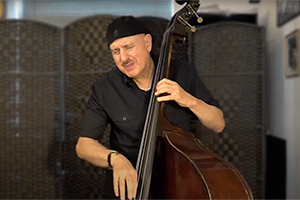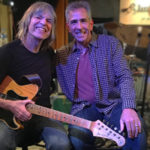NYC jazz bassist on new discovery of priceless 1985 recording
Exclusive interview with FBPO’s Jon Liebman
August 30, 2021
Harvie S’ presence on the NYC jazz scene is certainly hard to ignore. Known for pushing musical boundaries, the award-winning bassist, composer, and educator has released more than 35 albums as a leader or co-leader and has appeared on more than 375 as a sideman. Over the years, he’s performed and recorded with jazz giants Stan Getz, Chet Baker, Tony Bennett, Michael Brecker, Paquito D’Rivera, Chick Corea, Gil Evans, Art Farmer, Pat Metheny, and Zoot Sims. Since 1984, Harvie has served as Professor of Jazz Bass and Ensembles at Manhattan School of Music. This summer marked the release of his live album Going For It, which documents a legendary series of 1985 performances with Mike Stern and Alan Dawson.
FBPO: Can you relive the moment for me when you first learned that those 1985 sets had been recorded?
HS: It’s the funniest thing. I wanted to hit the guy over the head, but not in a mean way. [Laughs] I play a lot with Jerry Bergonzi, and usually when I go up there, my friend is there, and he loves to record. He’s recorded so many people and he’s very trustworthy.
FBPO: You’re talking about David Lee, right?
HS: David Lee. We talked about this gig, and he said, “Yeah, it was such a great gig.” Finally, I said to him, “You know, it’s really too bad we never got this recorded.” He says, “Oh, I got all three nights.” And that’s when I wanted to say, “What?!!”
FBPO: When did you find out?
HS: About two years ago. He sent me the raw footage. It took me about a year to really make something out of this, because the tunes were so long. There were issues with crowd noise ’cause it was a crazy, wild crowd. And there were issues where the cassette would run out in the middle of the tune or near the end, so there were tunes that we couldn’t use. I had to edit and realize that I can’t put out a record of four songs, and they’re all like 15 minutes, you know? So, I had to do a lot of work on the music, but I’m very happy with what came out. Everybody seems to be, including Mike Stern and company. Everybody’s very happy.
FBPO: Listening to the album, I couldn’t believe it when I read that the music was recorded on a cassette recorder! That blew me away.
HS: Yeah. But it’s not a cheapo cassette. It was one of those very good high-end Sony cassettes, with two good microphones.
FBPO: Okay, but it was still a cassette.
HS: It was still a regular cassette.
FBPO: Unbelievable. The performances were truly exceptional. All three of you sound great.
HS: Thank you, thank you. You know, it was magic in the air in those three nights.
FBPO: I’ve got to tell you, I’ve been following Mike Stern for many years and I honestly think his performance on this album is about the best I’ve ever heard him play.
HS: You’re not the only one to say that.
FBPO: He was really on.
HS: He wasn’t in his body. You know, he was in another place.
FBPO: There’s some great bass playing on the record, too!
HS: Well, thank you. I will admit I was inspired by, you know, Mike Stern. And Alan Dawson, who was like the guru of the drums, you know.
FBPO: What’s been keeping you busy since we last spoke?
HS: Well, you know, it’s been an amazing time in my life. Two great things happened in my life. One is, I invented an amplifier, called the UpShot. Acoustic Image makes it, and it’s their biggest seller. It’s the most incredible-sounding amp. I didn’t build the electronics, [but] It was my idea, my concept. The whole thing weighs about 14 pounds and goes into a backpack, so you can walk around with it, while having your hands free to carry a bass.
FBPO: It’s got a speaker in it too?
HS: Oh, you bet. The most acoustic sounding speaker that you can imagine.
FBPO: What else have you been doing?
HS: I’ve been playing a lot, for about eight or nine years, with Alan Broadbent, who’s truly one of the greatest living pianists and arrangers. He’s made a lot of records, but he doesn’t really love to record in the studio. So I ended up saying, “I really want to record.” And he just wasn’t happy about going in the studio, so I ended up buying a machine, and saying, “Let’s get together and do some recording!” So he has piano tuned, we set up and I recorded it. That ended up becoming the record New York Notes on High Notes Savant, which was on the charts for four months. In the meantime, I’ve been recording a bunch of people. I’m in the process of recording with Roberta Piket and Billy Mintz. I recorded with the James Weidman trio, with Alvester Garnett, and a CD with Roni Ben-Hur and Sylvia Cuenca. A lot of it is just done in my house or anywhere. So it’s been an interesting time. Plus, a lot of people have been hiring me to help them mix. I’ve been doing a lot of producing, mixing, and recording. It’s been kind of a new thing in my life.
FBPO: Tell me about the rest of your equipment and your instruments.
HS: I’ve gotten very close with Barrie Kolstein and the Kolstein bass shop, which has been great. They have a new version of their Heritage strings. I’m very hooked on their strings. Secondly, they sell a pickup. They don’t make it, but they sell it. It’s called Planet Wing and it’s made in Denmark. It’s by far the best pickup I’ve ever used. I travel with the Kolstein Busetto bass, which is just phenomenal. You can’t tell the difference between that [and] the regular acoustic bass, but it’s smaller and more portable. Basically, I fly with my Busetto Bass and I walk on the airplane with my UpShot. And then when I get to the gig, I’m in total grooveland, you know, I’m so happy. Kolstein makes a really nice bass cover, and the Kolstein rosin is just great. I’ve really become a Kolstein guy. Their equipment is the best.
FBPO: What advice do you have for someone who wants to learn bass?
HS: First thing, I’m talking about acoustic bass right now, ’cause bass guitar and acoustic bass, they’re very different instruments because one is in the guitar family, one’s from the string family. Even though they may function the same way as such, they’re different. So when we talk about acoustic bass, when I teach, I really try to explain to my students how to play the instrument economically and not hurt themselves with their left hand, how to use their left hand and not go to the hospital ‘cause it’s so easy to hurt yourself playing the instrument. I talk about that and how to use your right hand efficiently, so that you can play more accurately. That’s very important. Then, of course, I put out my 10 Duets and I think those are extremely valuable. Every duet is a lesson on how to play time, intonation, some double stops, reading, and how to develop really solid bass lines. And to understand that when you play the bass, it’s like to learn, really, how to make other people sound better.
FBPO: Ahh, I love that!
HS: And I have a bass mantra: “A bass line is only as good as how it makes the other members of the band sound.”
FBPO: I love it.
HS: That is my bass mantra. You should say that every time before you play. And it’s not about solos, this is about that. Solos is another world, but essentially you can be the worst soloist in the history of music, and if you play great bass lines and make a band sound good, you’ll work and people will hire you. And my other quote is: “I’ve never heard of a bass player getting fired for playing too many roots.”
FBPO: I love that too. What about for the electric bass?
HS: Well, for electric bass, it’s really the same kind of things that I’m saying, but you know, with that instrument, it’s really a guitar. You can do chordal stuff, and you can do the slapping, although you can slap acoustic, I know. But what you can do on that bass, it’s really, it’s a whole other thing. And the whole idea is to try to take those techniques and make them work in the music, not just to the techniques for the sake of techniques.
FBPO: Anything else coming up in the future that you haven’t already mentioned?
HS: Over the years, I’ve had a long history with Sheila Jordan. We had the bass and voice for about 14 years and made a lot of records and did a lot of touring. Then I stopped doing it for a long time. But over the past six, seven years we’ve been playing together again, mostly with groups or with Alan Broadbent. We’re in the process now of doing a thing with Roni Ben-Hur, the great guitarist, where it’s just me, Sheila, and Roni, and we’re reviving the music from her very first CD, from 1962. Sheila’s going to be 93 in November. We’ve already been commissioned to make a CD for HighNote Savant. We’re going to make a recording of all those tunes that she recorded then, because she, through her whole career, has never really recorded again with guitar. She’s done everything with piano or with bass, so this is really exciting. I’m going to play at Birdland for three nights with her, with Alan Broadbent, to celebrate her 93rd birthday, November 18, 19 and 20. And then the week before, November 10 and 11, we’re going to be at the Jazz Forum. We’ll do it with Billy Mintz on drums and Alan Broadbent on piano, so I’m pretty excited about that. And the other thing I want to mention is, I hadn’t done anything as a leader for a long time. And did it co-leading with Roni Ben-Hur. It’s on Jazzheads Records. It’s called Introspection. And I think it’s really a beautiful CD, so that’s pretty much my life in a nutshell. What can I say? I’m happy.
See Jon’s blog, with key takeaways from this interview here.
Going For It, Harvie S trio, with Mike Stern and Alan Dawson, is available here:





